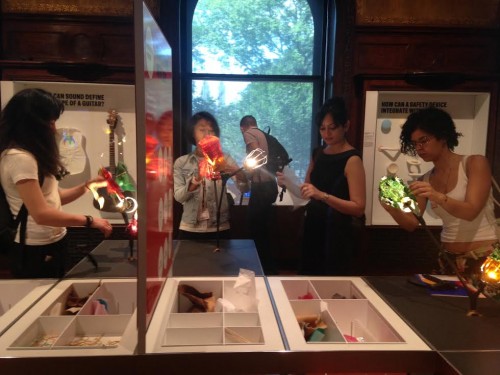
Salma Shamel Bakr speaking at the 2017 New School Commencement ceremony.
by Susan Yelavich
I’d like to offer some reflections as you embark on new paths, having spent the last two years, preparing for this moment. And I’m sharing them here for those who will follow your footsteps and those friends and colleagues who will miss you greatly. Myself, chief among them. Above all, I want you to know that if you felt your time here slipped away far too quickly, that I felt it just as keenly. The Irish in me thinks “we hardly knew ye.”
But, what I do know is that you are a forceful lot. Your exhibition in the University Center’s Events Café confirmed that. You are a class fully committed to the possibilities of Design Studies. Put another way, you didn’t hesitate to question the norms of design. You weren’t just dissatisified with the conventional categories of design and the usual ways of designing, you also proposed alternatives and alternative futures. And in doing so, you confirmed the value of Design Studies. It’s the canary in the coalmine at a time when we need it most: in this very moment, when the environment and civil society are under siege. We may not be the New York Times or the Washington Post, but our questions are no less valuable for that. Design Studies looks beyond the immediate present, a present we all hope will pass soon. We need to ask the questions you ask – questions that make us look at design in unexpected ways and in unexpected contexts.
Who would have thought that a national archive could be designed to suppress information? Salma Shamel Bakr’s investigations threw a harsh light on how archival systems and buildings, on how paper and pixels, can be, and have been, designed to deny history.
Who would have thought the American desert was an object of design? Fattori Fraser showed us that this most barren of landscapes is especially vulnerable to human interventions — precisely because it’s an environment that thrives of a myth of isolation. But what happens in the desert – think, nuclear testing – doesn’t stay in the desert, no matter what they say.
Who would have thought that childbearing was a matter of design? Sandra Gichuhi showed us how the labor of women—and I mean that in every sense of the word—is now built into a complex transnational network of lives and bodies.
Who would have thought that we design the lives of animals—including we human animals—in the muck of our barnyards? Shea Mandolesi took the lay of that land and redesigned a farm to promote better health.
Who would have thought that a world-famous architect was not completely in control of her work? Qionglu Lei broke through the fiction of the lone maestro, to reveal the wider cast of characters that make up a building, including those who use it.
And lastly, speaking of control, who would have thought design was more about erasure than mark, more about reconfiguring than configuring? Leticia Oxley found the essence of designing in prototyping, not in the ever-elusive idea of resolution. She, like all of our students, knows while every work of design addresses a question, it also poses countless others.
Keep questioning, stay curious, and stay in touch!




